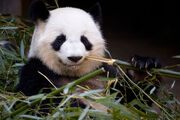
One of the most famous and easily recognized animals in the world, the giant panda (Ailuropoda melanoleuca) is also one of the most endangered. Scarcely 1000 individuals are believed to survive in the wild - in central and south-western China - with another 140 animals in zoos across the world. Habitat loss and poaching are the major dangers, and because the panda has a very slow reproductive cycle, it takes a long time for populations to recover. Females usually give birth to two cubs, one of which survives and stays with the mother for up to three years. In a lifetime, a female may raise only 5-8 cubs.
A panda's diet is almost exclusively bamboo, occasionally supplemented by other grasses and small rodents. Its digestive system is ill-equipped to digest the fibrous bamboo efficiently, so it has to spend most of its days foraging and eating. An elongated wrist bone with a fleshy pad of skin forms a functional but awkward thumb which is used to grasp the stems, and strong teeth then crush them into a more digestible pulp.
Pandas were once thought to be solitary creatures. However, new evidence suggests that small social groups may form outside the breeding season. These well-loved animals are the focus of much detailed research, always aimed at preserving the species. Recent research into in-vitro fertilization of pandas may help in the battle to prevent extinction.

















